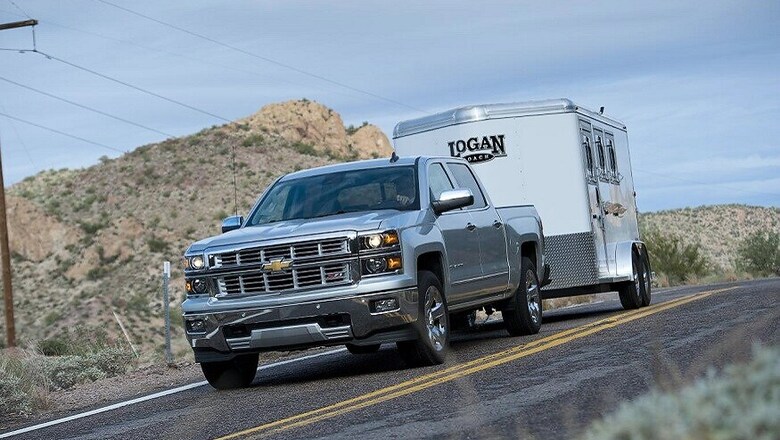
views
General Motors Co is intensifying its attack on rival Ford Motor Co's lead in sales to U.S. commercial fleets to prop up profit margins amid weakening consumer demand, according to executives at the No. 1 U.S. automaker. GM is counting on new medium-duty Silverados - outfitted as tow trucks, utility bucket trucks and delivery trucks - to lift demand for its light-duty trucks and cars. Automakers estimate for every medium-duty truck a corporate customer buys, they purchase up to six pickup trucks, SUVs, or passenger cars. The need for automakers to bolster U.S. sales and keep plants humming was highlighted last week when GM slated five North American factories for potential closure, including two making the type of sedan that has fallen out of favor with American consumers. Ford announced it would shuffle workers from slower to busier plants.
Vote Now! Tech And Auto Awards 2018 is here. Click here to vote for your favourite gadgets and cars.
Most major automakers also reported lower U.S. November sales. But a 24.1 percent jump in commercial fleet sales in November versus the same month in 2017 helped GM offset a 1 percent retail sales drop, according to a source briefed on figures GM does not make public on a monthly basis.
GM North America chief Alan Batey told Reuters in a recent interview the automaker has pursued a long-term strategy to cut lower-margin rental fleet sales and boost more lucrative commercial sales. GM's rental sales are around 10 percent of total sales this year, down from 15.8 percent in 2013, according to industry data. In the same period, GM's commercial sales have risen to more than 11 percent from 7.8 percent of sales.
Batey said production of GM's medium-duty trucks, which begins this week under a partnership with truck maker Navistar International Corp as an extension of the Chevrolet Silverado pickup truck model line, is a milestone in the automaker's move to increase market share.
GM exited the segment during its bankruptcy in 2009. It originally announced the planned Navistar venture in September 2015. GM and Ford compete for business from companies like engineering-services firm U.S. Infrastructure Co, which has around 9,000 vehicles, mostly light-duty Chevrolet Colorado pickup trucks. USIC's workers mark cable lines, water pipes and other underground infrastructure before contractors start digging holes in the ground.
USIC fleet manager Phil Samuelson said in a recent interview the company needs around 20 medium-duty trucks, fast. GM won his order by promising to accelerate production of his trucks. Otherwise, Samuelson would have tried Ford or Fiat Chrysler Automobiles NV.
"We have a great relationship with GM and we saw no reason not to continue that," he said. Satisfying customers like USIC could help GM next year when Ford launches its Ranger pickup, a direct competitor for the Colorado.
Rising commercial fleet sales have lifted GM's net profit by $1 billion over the last five years, according to sources familiar with GM's financials.
Boost From Tax Overhaul
Commercial fleet sales are increasingly important as consumer vehicle sales are set to weaken over the next couple of years after an eight-year recovery. Ford, GM and FCA control around 77 percent of commercial fleet sales for Classes 1 through 6 - from passenger cars to the biggest medium-duty trucks - though Ford dominates at 40 percent, according to data compiled by Cox Automotive for Reuters from non-public sources. GM has around 25 percent market share.
Ford executives say they have no special plans to counter GM's expanded truck portfolio. "We're just going to do what we always do," said John Ruppert, Ford's general manager for commercial vehicle sales.
Through November, GM's commercial fleet sales rose 13.5 percent compared with a 5.1 percent increase at Ford. U.S. auto retail sales are forecast to fall over the next two years. But commercial fleet sales should rise, partly because of tax write-offs in the 2017 U.S. federal tax overhaul.
"If retail sales come down, your factories are still humming ... if you're selling to commercial fleets," said Zohaib Rahim, Cox Automotive's economic and industry insights manager.
Desperate Need
GM's decision to re-enter the medium-duty truck segment was driven by commercial customers that seek several types of vehicle in package deals.
"If I want a medium-duty truck I end up going to Ford and the chances are I'll also buy my pickup truck from Ford instead of GM," said Kenny Vieth, president of sales forecasting firm ACT Research.
"Dealers desperately need these trucks to go after industries we haven't been able to go to with existing product," said John Schwegman, GM's commercial product director.
Keith McCluskey, owner of McCluskey Chevrolet in Cincinnati, Ohio, said his commercial fleets now account for 10 percent of his sales, down from 40 percent when he last sold GM medium-duty trucks.
McCluskey has built a new $8 million service facility partly for commercial customers and aims to sell 1,000 medium-duty trucks annually.




















Comments
0 comment